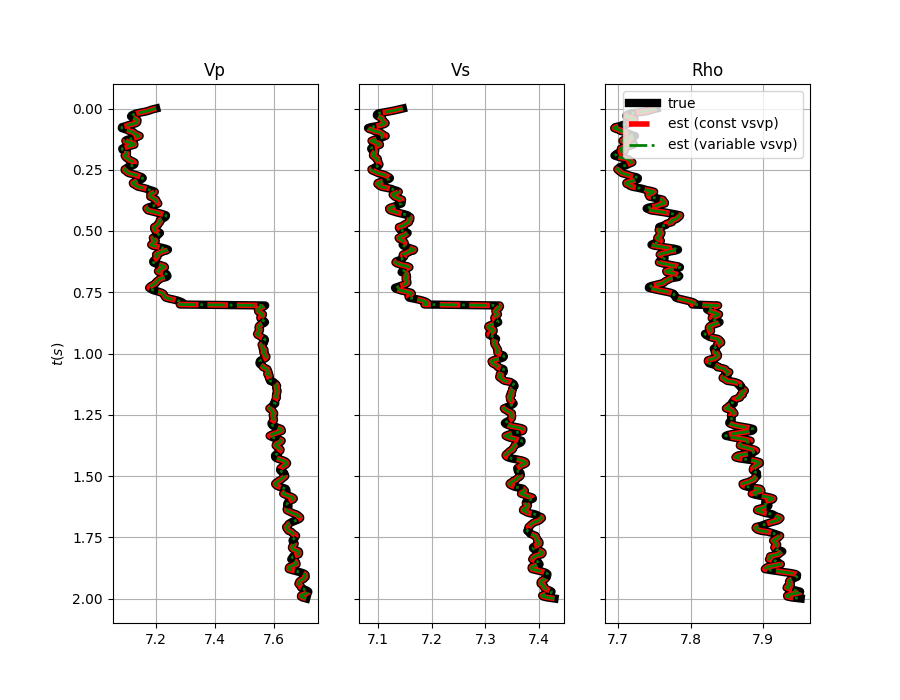Note
Click here to download the full example code
AVO modelling¶
This example shows how to create pre-stack angle gathers using
the pylops.avo.avo.AVOLinearModelling operator.
Let’s start by creating the input elastic property profiles
nt0 = 501
dt0 = 0.004
ntheta = 21
t0 = np.arange(nt0)*dt0
thetamin, thetamax = 0, 40
theta = np.linspace(thetamin, thetamax, ntheta)
# Elastic property profiles
vp = 1200 + np.arange(nt0) + filtfilt(np.ones(5)/5., 1, np.random.normal(0, 80, nt0))
vs = 600 + vp/2 + filtfilt(np.ones(5)/5., 1, np.random.normal(0, 20, nt0))
rho = 1000 + vp + filtfilt(np.ones(5)/5., 1, np.random.normal(0, 30, nt0))
vp[201:] += 500
vs[201:] += 200
rho[201:] += 100
# Wavelet
ntwav = 41
wavoff = 10
wav, twav, wavc = ricker(t0[:ntwav//2+1], 20)
wav_phase = np.hstack((wav[wavoff:], np.zeros(wavoff)))
# vs/vp profile
vsvp = 0.5
vsvp_z = np.linspace(0.4, 0.6, nt0)
# Model
m = np.stack((np.log(vp), np.log(vs), np.log(rho)), axis=1)
We create now the operators to model the AVO responses for a set of elastic profiles
# constant vsvp
PPop_const = \
pylops.avo.avo.AVOLinearModelling(theta, vsvp=vsvp,
nt0=nt0, linearization='akirich',
dtype=np.float64)
# depth-variant vsvp
PPop_variant = \
pylops.avo.avo.AVOLinearModelling(theta, vsvp=vsvp_z,
linearization='akirich',
dtype=np.float64)
We can then apply those operators to the elastic model and create some synthetic reflection responses
dPP_const = PPop_const *m.flatten()
dPP_const = dPP_const.reshape(nt0, ntheta)
dPP_variant = PPop_variant *m.flatten()
dPP_variant = dPP_variant.reshape(nt0, ntheta)
Finally we invert these data and estimate the underlying elastic profiles
# from constant vsvp
mest = PPop_const / dPP_const.flatten()
mest = mest.reshape(nt0, 3)
# from depth-variant vsvp
mest1 = PPop_const / dPP_const.flatten()
mest1 = mest.reshape(nt0, 3)
fig, axs = plt.subplots(1, 3, figsize=(9, 7), sharey=True)
axs[0].plot(m[:, 0], t0, 'k', lw=6)
axs[0].plot(mest[:, 0], t0, '--r', lw=4)
axs[0].plot(mest1[:, 0], t0, '-.g', lw=2)
axs[0].set_title('Vp')
axs[0].set_ylabel(r'$t(s)$')
axs[0].invert_yaxis()
axs[0].grid()
axs[1].plot(m[:, 1], t0, 'k', lw=6)
axs[1].plot(mest[:, 1], t0, '--r', lw=4)
axs[1].plot(mest1[:, 1], t0, '-.g', lw=2)
axs[1].set_title('Vs')
axs[1].invert_yaxis()
axs[1].grid()
axs[2].plot(m[:, 2], t0, 'k', lw=6, label='true')
axs[2].plot(mest[:, 2], t0, '--r', lw=4, label='est (const vsvp)')
axs[2].plot(mest1[:, 2], t0, '-.g', lw=2, label='est (variable vsvp)')
axs[2].set_title('Rho')
axs[2].invert_yaxis()
axs[2].grid()
axs[2].legend()

Out:
<matplotlib.legend.Legend object at 0x7f8357772d30>
Total running time of the script: ( 0 minutes 0.366 seconds)